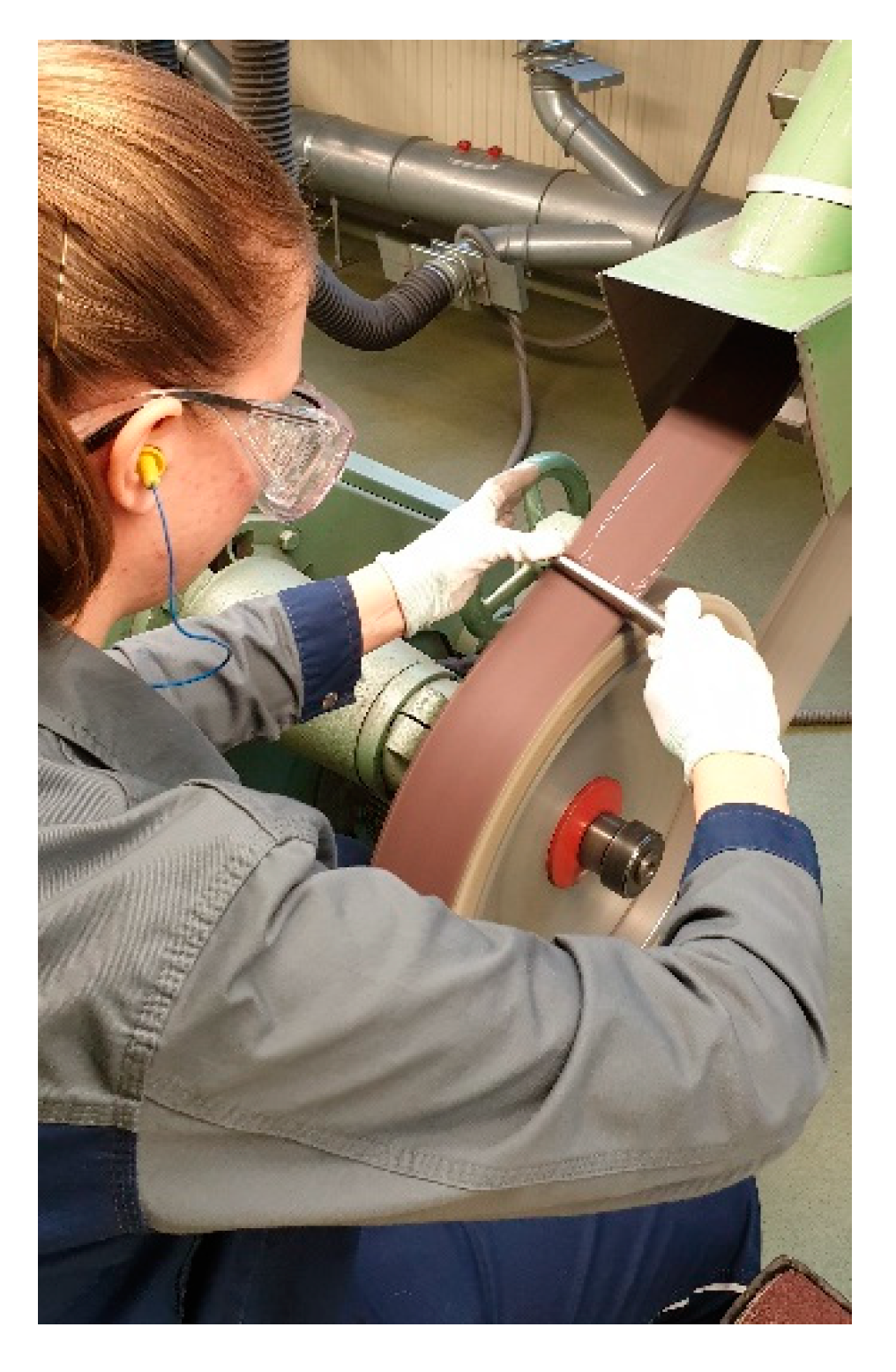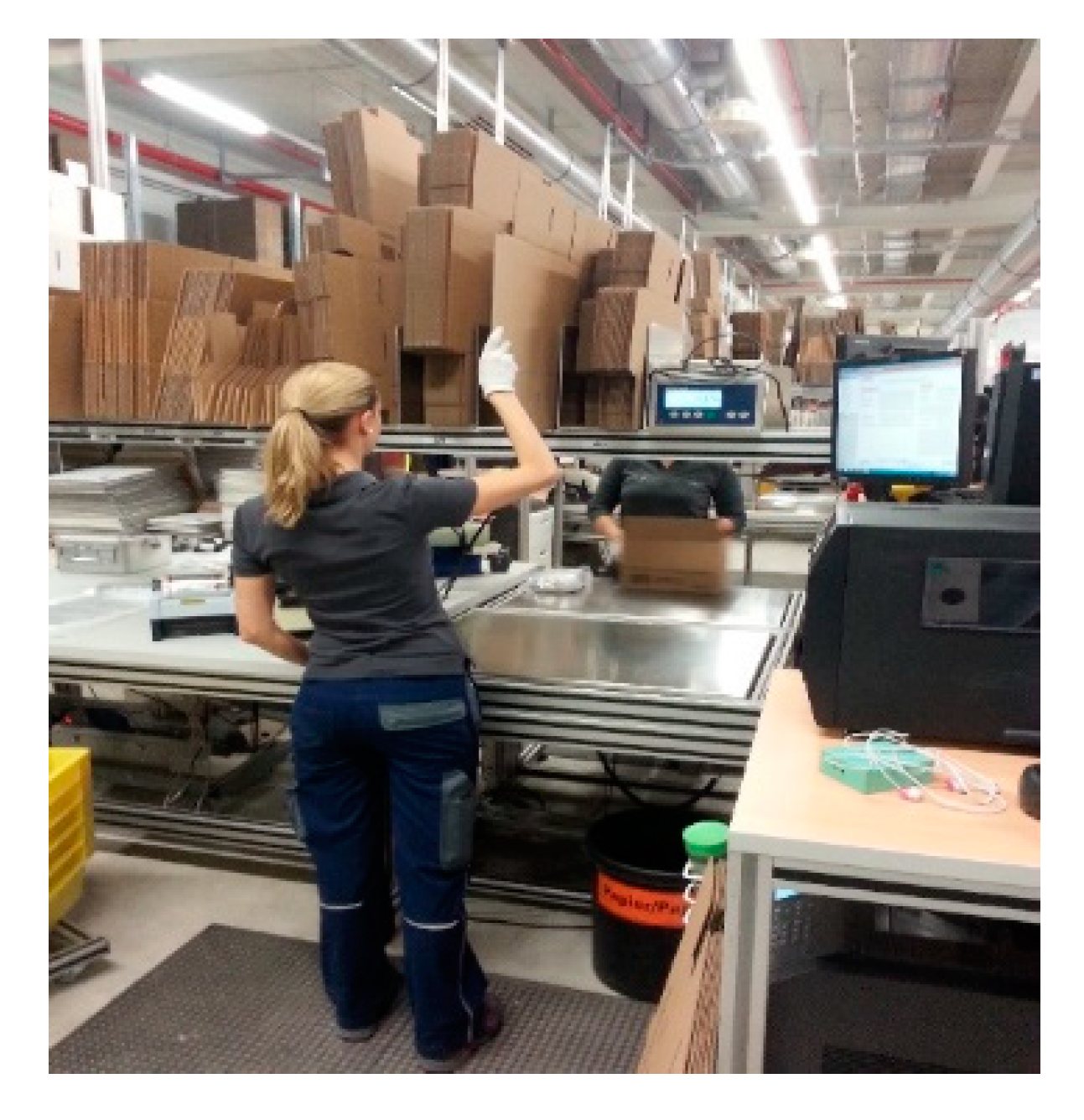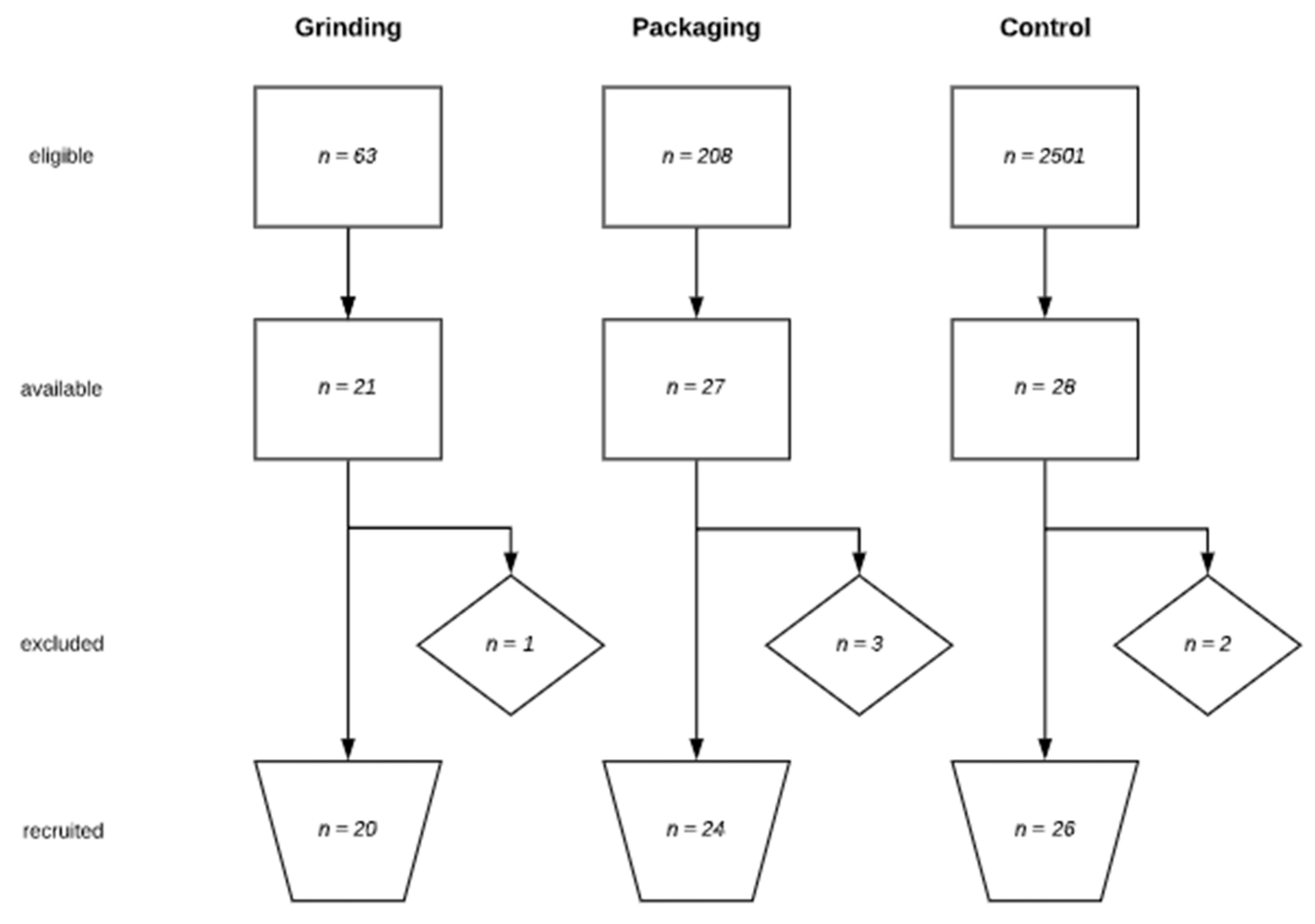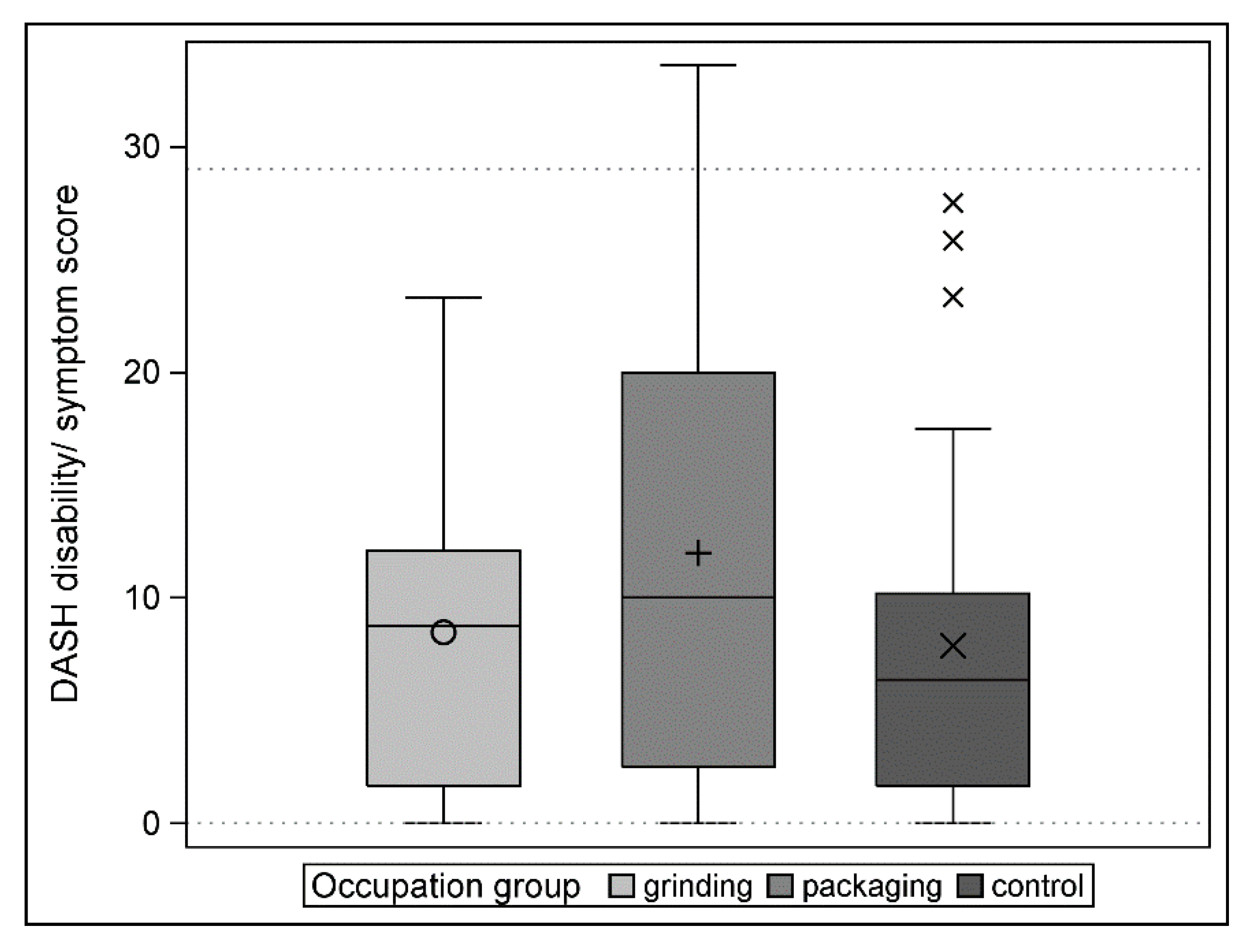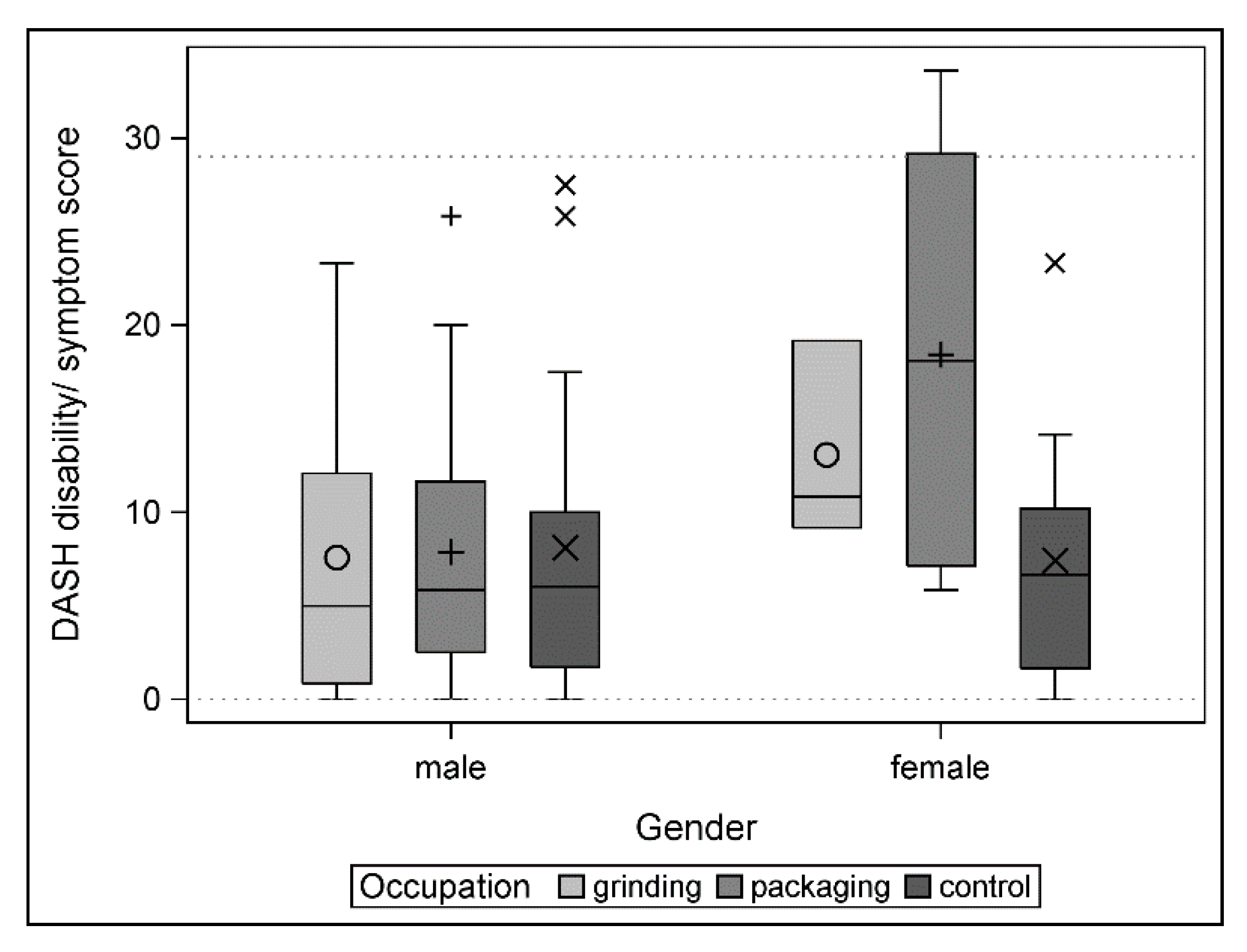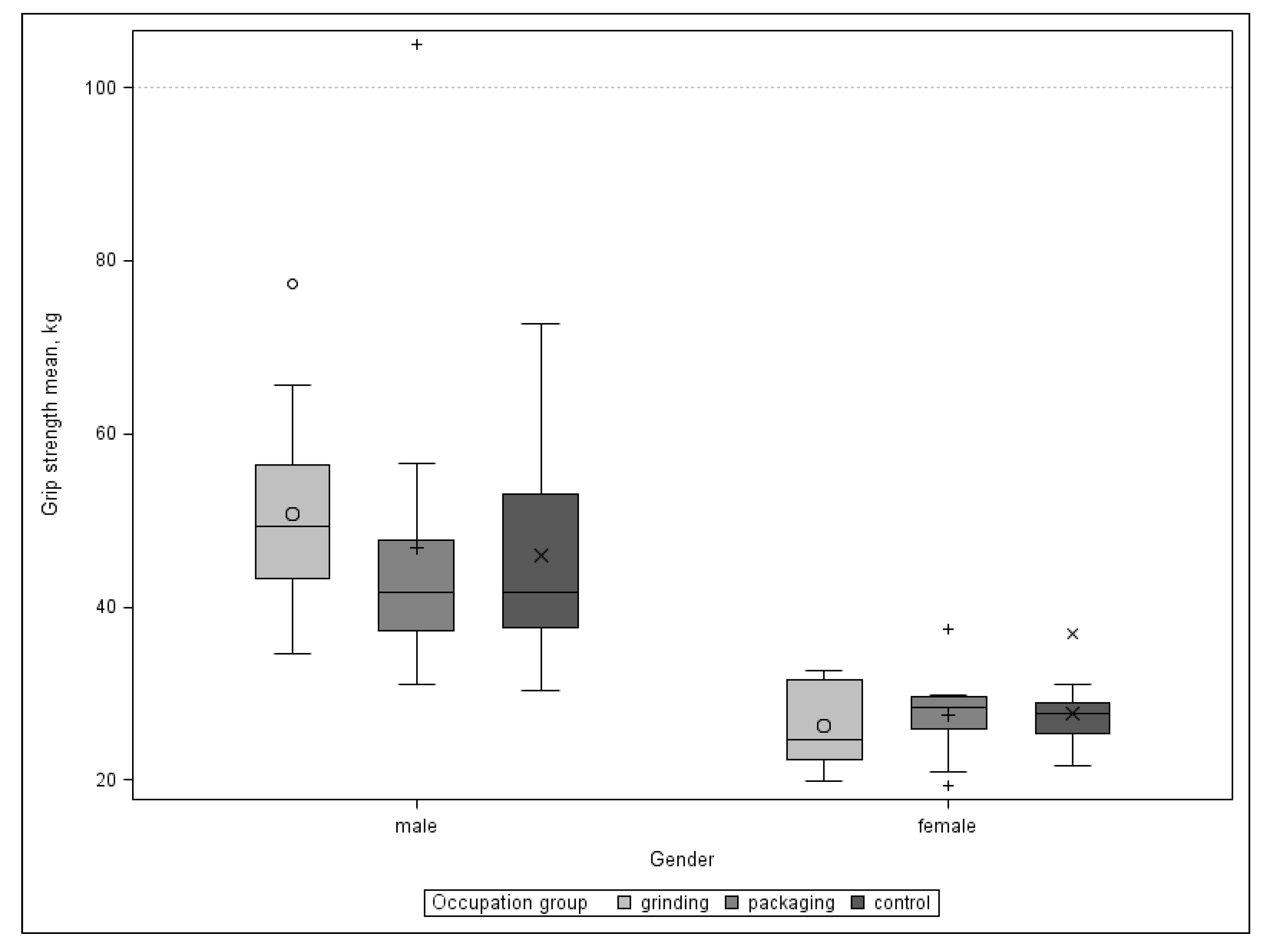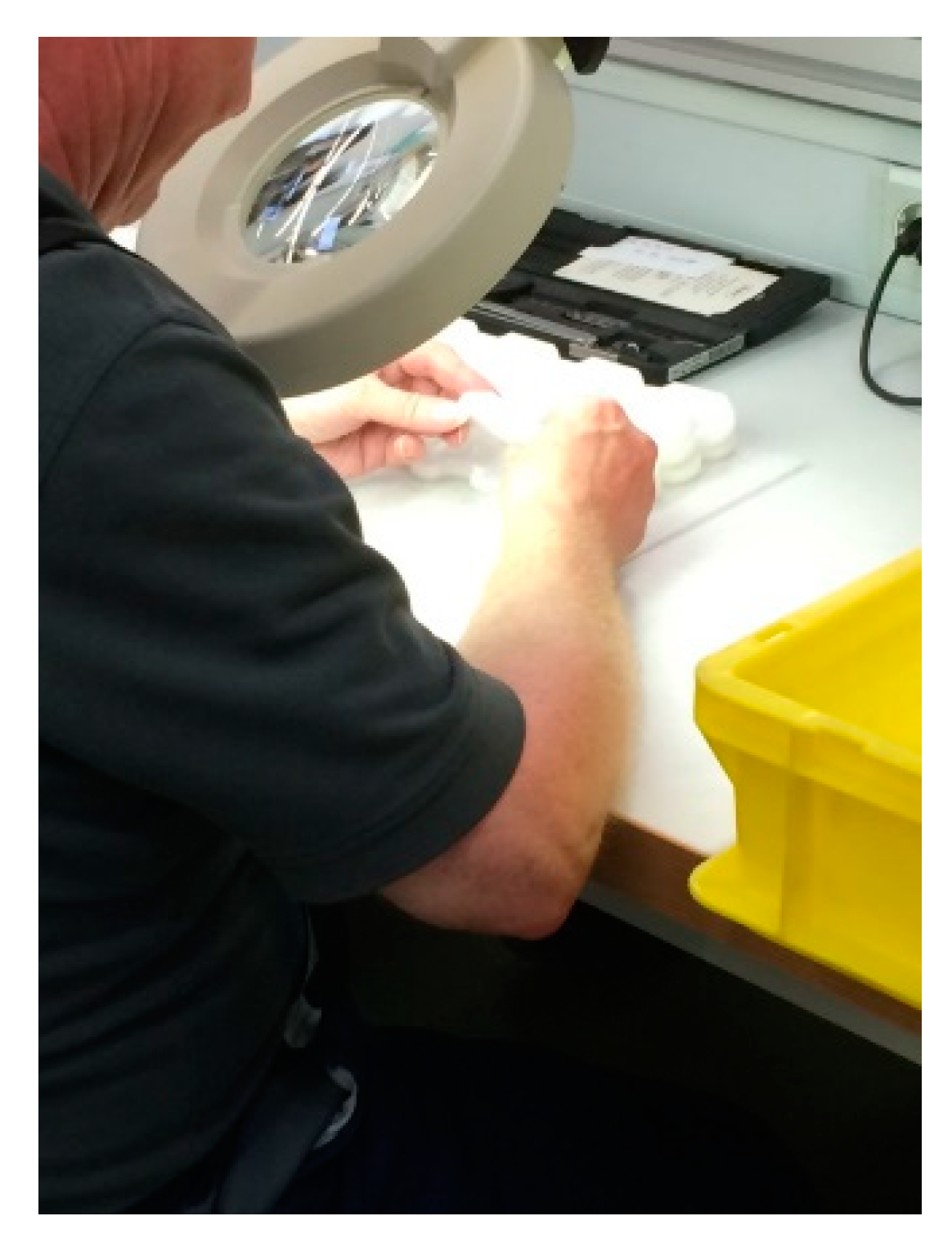Upper extremity WMSDs represent a range of disorders of the muscle, tendon, or nerve that also can occur in non-workplace settings with a similar or identical pathophysiology [
16,
41]. Musculoskeletal disorders are the most expensive disease category with regard to work absenteeism and disablement. We chose to survey a population of actively employed surgical device mechanics and compared them with a group of employees believed not to be exposed to repetitive hand and arm movements to such a large extent.
We conducted this prospective study at the headquarters and main production site of Aesculap AG, which is a leading manufacturer and global player in the surgical instrument industry, located in a medical technology cluster region [
42,
43]. Among other things, the company is valued for its comprehensive preventive medical treatment programmes that are easy for all its employees to access. One of the basic requirements for our study was for many of the employees to have been with the company for a long time and to have had a constant workplace over a long period of time.
4.1. DASH and Other Measurement Values
The DASH outcome measure has proven to be a reliable and valid instrument to measure physical function and symptoms in upper extremity musculoskeletal complaints, including WMSDs [
44,
45]. It is the best instrument for evaluating patients with upper limb joint disorders [
46].
As in previous studies, it was observed that a non-clinical “normal” population does not have a zero value [
47]. Both groups of manual workers tested in the current study proved their statistical equivalence with the control group. Since our equivalence margins correspond to the minimal clinically important difference (MCID) for the DASH score, we were able to state that neither grinders nor packers were clinically different from the control group. The mean DASH score in our investigation was 8.5 (SD 7.6) points for the grinder group, 12.0 (SD 10.6) points for the packer group, and 7.9 (SD 8.1) points for the control group. Although the control group had the best (=lowest DASH) score, the differences were not statistically significant. The reference value of 10.1 (SD 14.7) points was only exceeded by the packers; the other two groups were better than this threshold.
Surprisingly, it is not the grinders with their loading and repetitive activity tasks that have the highest (=worst) DASH score, but the packers whose work tasks are defined as repetitive with less loading and more variability in the movement sequences. This finding contrasts with a study which has shown significant differences in DASH scores between manually demanding and manually low-demanding jobs in favour of the latter [
48]. One reason for this could be that working hours and job designs have changed significantly in the medical device industry in recent decades so there may be no relevant differences to other occupational groups with a lower workload. A lot of grinders repeatedly carry out pre-processing and post-processing activities, which lead the grinder away from the whetstone during a shift at today’s modern workplaces. This is not the case with packers who mainly carry out the same work throughout a shift. A further explanation could be that the grinders are usually very experienced specialists who would be hard to replace in the event of health problems. This means that there is a particularly high level of motivation on the part of employers for health protection measures in this group. According to common doctrine, static work processes favour the development of upper extremity WRMDs, which should represent a risk for grinders [
49]. In reality, however, there is no difference from the somewhat more variable and multidimensional movement sequences of the packers. It may even be possible that microvibrations in grinders could have a prophylactic effect preventing the development of WRMDs in the upper extremity [
50].
The average values of the three investigated groups correspond to those of a population not employed in manual work. A literature review showed that our scores are generally lower than in most studies that have analysed normative values in the general population outside clinical settings [
37,
48,
51,
52,
53]. We gained the impression that some test subjects had previously reported clinical complaints well below a DASH score of 29, which was defined by Williams as a kind of threshold [
54]. In our sample, the risk of packers having clinically relevant complaints (DASH invalidity/symptom score >29) was higher (odds ratio 8.63 (0.40; 186.88)) than in the control group. However, this did not reach statistical significance.
Interestingly, the DASH showed a homogeneous distribution between the three groups in men, while women had a very inhomogeneous distribution. The influence of age (increasing DASH scores with increasing age) and gender (higher DASH scores in women) as well as further co-variates in this context will be topic of our future studies [
48,
52].
Active range of motion of the wrist and pain on the visual analogue scale (VAS) showed no abnormalities or relevant differences between the groups. The measured values for grip strength were partly below the published reference values, taking into account handedness, age, and sex [
38,
48]. In the Purdue Pegboard Tests our subjects mostly performed below than the reference values given [
40,
55]. This result is astonishing, because we would have expected a different result, especially for packers’ repetitive and fine motor activities as well as for those of numerous workplaces in the inspection department.
4.2. Prevalence of Symptoms and Diagnoses
The design of our cross-sectional study with a control group, physical examination of the subjects, and the use of a questionnaire can be found in several studies related to different industries. Our literature research showed a prevalence of upper extremity pain (i.e., symptoms) of between 21% and 71% in the study group and between 6% and 50% in the control group [
56,
57,
58,
59,
60,
61,
62,
63,
64,
65,
66,
67,
68]. This is in line with our investigation where symptoms were reported in the first questionnaire by 8/20 (40%) grinders, 14/24 (58%) packers, and 11/26 (42%) people in the control group.
In most studies, only the symptoms of musculoskeletal disorders of the upper extremity were described, instead of additionally identifying pathognomonic clinical signs (i.e., diagnoses). In the latter the prevalence has ranged from 21% to 56% compared to 5% to 22% in the control group [
57,
58,
60,
61,
62,
64]. Upper limb musculoskeletal disorders were diagnosed in 14/20 (70%) grinders, 13/24 (54%) packers, and 11/26 (42%) of the test persons in the control group for our investigation, with bilateral manifestation in approximately one third of cases. Thus, the frequency of reported symptoms is lower than the frequency of detected musculoskeletal disorders in our study, in contrast to previous studies which showed a high prevalence of complaints but a relatively low number of definite diagnoses [
69,
70]. One explanation could be the rather low sensitivity of the questionnaires to upper extremity complaints (42%–65%), as already found by Ohlsson et al., which underlines the need for a combination of questionnaire and clinical investigation in such cross-sectional studies [
71]. Another aspect could be the focus on diseases of the elbow, forearm, wrist, and hand in our investigation, which did not consider more proximal pathologies of the upper extremity, such as shoulder disorders. The latter are sometimes unspecific and there are hardly any pathognomonic clinical tests to make a reliable diagnosis. This could, in turn, lead to a gap between symptoms and diagnoses of diseases.
It has been shown that musculoskeletal disorders in different body regions are associated with different branches of industry. Lateral epicondylitis, wrist tendinitis and carpal tunnel syndrome are considered the most common diseases [
57,
60,
61,
62,
64,
70]. In our investigation, 30% of all test persons and 54% of the subjects with upper extremity complaints had signs of medial epicondylitis (golfer’s elbow) and nerve entrapment at the medial elbow (cubital tunnel syndrome), followed by lateral epicondylitis (tennis elbow) in 14% and 27%, respectively. Our literature research revealed a prevalence of medial epicondylitis (golfer’s elbow) of 3% to 20% in occupational settings associated with forceful activities but without clear reference to repetitive work [
64,
72,
73,
74,
75]. Medial epicondylitis occurs in only 10%–20% of all epicondylitis as a result of common flexor tendon microtrauma and degeneration, affects men and women equally, and is often associated with cubital tunnel syndrome [
76]. We were able to confirm this above-average prevalence and the frequent co-occurrence of the two pathologies in our study. The risk for grinders of developing upper extremity WMSD was higher than in the control group (odds ratio 2.59 (0.76; 8.78)). However, there was no statistically significant increased occurrence of these pathologies in any of the groups.
4.3. Interpretation of the Results
We hypothesised that there would be no clinically relevant differences in the prevalence of upper extremity WMSDs between surgical device mechanics with specific repetitive work tasks, with and without forceful exertions, compared to other employees in the same industry. We were able to confirm this with surgical device mechanics not seeming to be at higher risk of upper limb WMSDs compared to the control group. Although grinders and packers had higher DASH values than the control group, this difference was of no clinical relevance and statistically not significant. However, there are partly contradictory statements in this regard from other sectors of industry [
12,
13,
14,
15,
76]. The reasons for our findings are probably that the exposed groups did not vary much in terms of their physical workload and repetitive work tasks. However, since WMSDs represent a complex condition that can be influenced by individual, environmental, psychosocial, and organizational factors, this simplified interpretation is only one possible aspect in a multi-level approach with numerous interactions and thus might explain some contradictory results [
77,
78]. Variations in the duration of exposure, work interruptions through less monotonous and stressful pre-processing and post-processing activities, psychosocial factors, the level of training, and income disparities may have such an influence that the primary work tasks lose relevance with regard to upper extremity WMSDs [
65,
66].
The diagnostic patterns observed in this investigation were, in general, consistent with medial epicondylitis and cubital tunnel syndrome in the elbow. Lateral epicondylitis, tenosynovitis in the wrist, and carpal tunnel syndrome were underrepresented. This can also be explained by the working positions at various workplaces, some of which were noticeable during our site inspections, with partially unpadded support of the elbows and proximal forearms on edges and surfaces (
Figure 7).
In addition to regular occupational health check-ups, the study company offers optional preventive medical check-ups for individual complaints. Furthermore, there are check-up programs for each employee on a voluntary basis to identify risk factors, preliminary stages of illness or diseases, and to be able to prevent or treat them in a targeted manner. In the latter case, a full-body profile is created including patient history, blood values, Electrocardiogram (ECG), lung function testing, visual and hearing tests, as well as a full body examination, including different organ systems. If particularities are identified during these examinations, further targeted measures may be taken. In the case of upper extremity WMSDs, hand therapeutic measures, ergonomic optimization of the workplace, and examinations by specialists (e.g., upper extremity surgeon) are usually initiated. Based on our study results, the response to the strikingly high rates of medial elbow pathologies should be an ergonomic sitting position and simple padding of the table edges. Longer periods of repetitive work, especially for packers, should be interrupted by other types of work, including job rotation as a preventive measure.
4.4. Limitations of Our Investigation
There is a possible evaluation bias as it was not possible to blind clinical evaluators due to the participants’ clothing (blue collar vs. white collar workers). Thus, we believe that the bias is small, if present. A selection bias is also likely as persons with upper extremity complaints could be more motivated to volunteer. However, since this effect applies equally to the study groups and the control group, it would be cancelled out and at the same time increase the total number of complaints. This last effect may partly be compensated by the healthy worker effect, which often results in the working population being statistically shown to be healthier than is actually the case. People with pain and functional disorders might leave their work, and cross-sectional studies thus may underestimate the risk. The only validated test available for our series is the self-reported DASH outcome measure. However, the ability of subjects with musculoskeletal disorders cannot be assessed on the basis of questionnaires alone. As in every questionnaire, the translation of scores from the questionnaire to functional capacity for work can be questioned. Furthermore, our cross-sectional data has inherent limitations, including the inability to clearly distinguish clinically between the chronic, recurrent, and acute symptoms we observed. In addition to biomechanical constraints, psychosocial factors with difficult-to-define effects have been shown to play a role in the genesis of WMSDs [
79,
80,
81]. We have not included this aspect as a contributing cause in our analysis to prioritise other questions and due of the high complexity of its evaluation. In fact, grinders are skilled workers with good pay, while packers are mostly lateral entrants and semi-skilled workers with lower incomes. As we performed a cross-sectional study, the causality of our reported pathologies could not be assessed. We could not adjust for workers’ baseline risk of WMSDs resulting from prior occupational exposures or other non-occupational exposures. In this case, a longitudinal study, including the time dimension, would be advantageous in order to better decide what changes should be made to working conditions. The overall very high level of preventive measures and occupational health care for the entire workforce could be a reason why no significant differences could be found between the groups. Despite the size of the company, the subdivision into specific working groups with certain tasks leads to a relatively small number of cases, which is especially true for the grinders. However, a smaller subdivision would have reduced the selectivity. The sample size was calculated based on anticipated effect in order to enable the proof of the study hypothesis of equivalence between occupational groups (see statistical analysis). The targeted sample size could not be achieved in all groups due to lack of consent in smaller subpopulations. Nevertheless, the actual sample sizes were sufficient to prove the study hypotheses.
Planning the current study, we assumed a normal distribution for the DASH score. The statistical analyses followed the a priori plan in order to maintain the significance level. The distribution analysis of the study data revealed an obvious ceiling effect, with 12 of 70 participants having the best score of 0 pts. Normal distribution-based statistical methods may lose sensitivity in terms of detecting differences between groups, with respect to the power to detect effects in such a situation. The ceiling is not unusual in studies using scores for outcome evaluation, particularly studies in orthopaedics, and should be taken into account when planning statistical analysis for future studies using DASH scores [
82].
